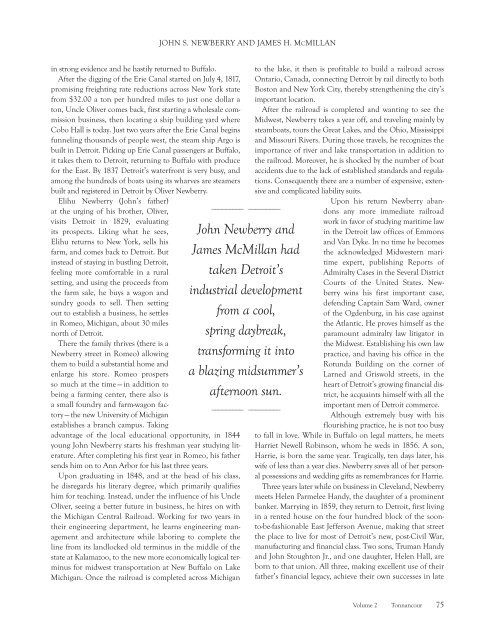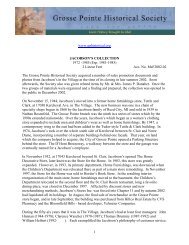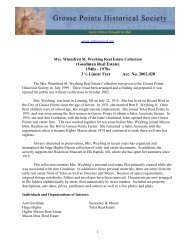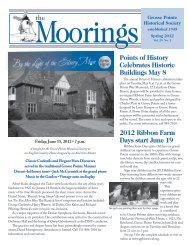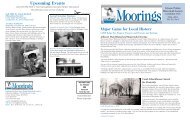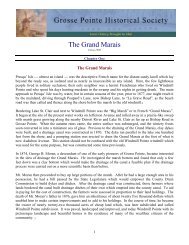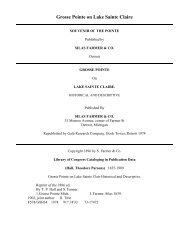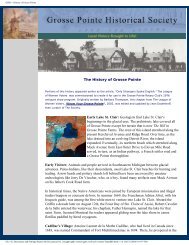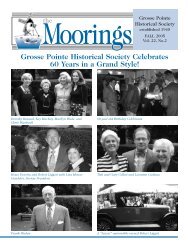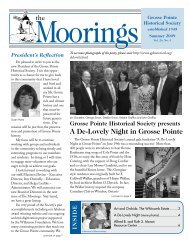John S. Newberry and James H. McMillan - Grosse Pointe Historical ...
John S. Newberry and James H. McMillan - Grosse Pointe Historical ...
John S. Newberry and James H. McMillan - Grosse Pointe Historical ...
You also want an ePaper? Increase the reach of your titles
YUMPU automatically turns print PDFs into web optimized ePapers that Google loves.
in strong evidence <strong>and</strong> he hastily returned to Buffalo.<br />
After the digging of the Erie Canal started on July 4, 1817,<br />
promising freighting rate reductions across New York state<br />
from $32.00 a ton per hundred miles to just one dollar a<br />
ton, Uncle Oliver comes back, first starting a wholesale commission<br />
business, then locating a ship building yard where<br />
Cobo Hall is today. Just two years after the Erie Canal begins<br />
funneling thous<strong>and</strong>s of people west, the steam ship Argo is<br />
built in Detroit. Picking up Erie Canal passengers at Buffalo,<br />
it takes them to Detroit, returning to Buffalo with produce<br />
for the East. By 1837 Detroit’s waterfront is very busy, <strong>and</strong><br />
among the hundreds of boats using its wharves are steamers<br />
built <strong>and</strong> registered in Detroit by Oliver <strong>Newberry</strong>.<br />
Elihu <strong>Newberry</strong> (<strong>John</strong>’s father)<br />
at the urging of his brother, Oliver,<br />
visits Detroit in 1829, evaluating<br />
its prospects. Liking what he sees,<br />
Elihu returns to New York, sells his<br />
farm, <strong>and</strong> comes back to Detroit. But<br />
instead of staying in bustling Detroit,<br />
feeling more comfortable in a rural<br />
setting, <strong>and</strong> using the proceeds from<br />
the farm sale, he buys a wagon <strong>and</strong><br />
sundry goods to sell. Then setting<br />
out to establish a business, he settles<br />
in Romeo, Michigan, about 30 miles<br />
north of Detroit.<br />
There the family thrives (there is a<br />
<strong>Newberry</strong> street in Romeo) allowing<br />
them to build a substantial home <strong>and</strong><br />
enlarge his store. Romeo prospers<br />
so much at the time — in addition to<br />
being a farming center, there also is<br />
a small foundry <strong>and</strong> farm-wagon factory<br />
— the new University of Michigan<br />
establishes a branch campus. Taking<br />
advantage of the local educational opportunity, in 1844<br />
young <strong>John</strong> <strong>Newberry</strong> starts his freshman year studying literature.<br />
After completing his first year in Romeo, his father<br />
sends him on to Ann Arbor for his last three years.<br />
Upon graduating in 1848, <strong>and</strong> at the head of his class,<br />
he disregards his literary degree, which primarily qualifies<br />
him for teaching. Instead, under the influence of his Uncle<br />
Oliver, seeing a better future in business, he hires on with<br />
the Michigan Central Railroad. Working for two years in<br />
their engineering department, he learns engineering management<br />
<strong>and</strong> architecture while laboring to complete the<br />
line from its l<strong>and</strong>locked old terminus in the middle of the<br />
state at Kalamazoo, to the new more economically logical terminus<br />
for midwest transportation at New Buffalo on Lake<br />
Michigan. Once the railroad is completed across Michigan<br />
JOHN S. NEWBERRY AND JAMES H. MCMILLAN<br />
————————— —————————<br />
<strong>John</strong> <strong>Newberry</strong> <strong>and</strong><br />
<strong>James</strong> <strong>McMillan</strong> had<br />
taken Detroit’s<br />
industrial development<br />
from a cool,<br />
spring daybreak,<br />
transforming it into<br />
a blazing midsummer’s<br />
afternoon sun.<br />
————————— —————————<br />
to the lake, it then is profitable to build a railroad across<br />
Ontario, Canada, connecting Detroit by rail directly to both<br />
Boston <strong>and</strong> New York City, thereby strengthening the city’s<br />
important location.<br />
After the railroad is completed <strong>and</strong> wanting to see the<br />
Midwest, <strong>Newberry</strong> takes a year off, <strong>and</strong> traveling mainly by<br />
steamboats, tours the Great Lakes, <strong>and</strong> the Ohio, Mississippi<br />
<strong>and</strong> Missouri Rivers. During those travels, he recognizes the<br />
importance of river <strong>and</strong> lake transportation in addition to<br />
the railroad. Moreover, he is shocked by the number of boat<br />
accidents due to the lack of established st<strong>and</strong>ards <strong>and</strong> regulations.<br />
Consequently there are a number of expensive, extensive<br />
<strong>and</strong> complicated liability suits.<br />
Upon his return <strong>Newberry</strong> ab<strong>and</strong>ons<br />
any more immediate railroad<br />
work in favor of studying maritime law<br />
in the Detroit law offices of Emmons<br />
<strong>and</strong> Van Dyke. In no time he becomes<br />
the acknowledged Midwestern maritime<br />
expert, publishing Reports of<br />
Admiralty Cases in the Several District<br />
Courts of the United States. <strong>Newberry</strong><br />
wins his first important case,<br />
defending Captain Sam Ward, owner<br />
of the Ogdenburg, in his case against<br />
the Atlantic. He proves himself as the<br />
paramount admiralty law litigator in<br />
the Midwest. Establishing his own law<br />
practice, <strong>and</strong> having his office in the<br />
Rotunda Building on the corner of<br />
Larned <strong>and</strong> Griswold streets, in the<br />
heart of Detroit’s growing financial district,<br />
he acquaints himself with all the<br />
important men of Detroit commerce.<br />
Although extremely busy with his<br />
flourishing practice, he is not too busy<br />
to fall in love. While in Buffalo on legal matters, he meets<br />
Harriet Newell Robinson, whom he weds in 1856. A son,<br />
Harrie, is born the same year. Tragically, ten days later, his<br />
wife of less than a year dies. <strong>Newberry</strong> saves all of her personal<br />
possessions <strong>and</strong> wedding gifts as remembrances for Harrie.<br />
Three years later while on business in Clevel<strong>and</strong>, <strong>Newberry</strong><br />
meets Helen Parmelee H<strong>and</strong>y, the daughter of a prominent<br />
banker. Marrying in 1859, they return to Detroit, first living<br />
in a rented house on the four hundred block of the soonto-be-fashionable<br />
East Jefferson Avenue, making that street<br />
the place to live for most of Detroit’s new, post-Civil War,<br />
manufacturing <strong>and</strong> financial class. Two sons, Truman H<strong>and</strong>y<br />
<strong>and</strong> <strong>John</strong> Stoughton Jr., <strong>and</strong> one daughter, Helen Hall, are<br />
born to that union. All three, making excellent use of their<br />
father’s financial legacy, achieve their own successes in late<br />
Volume 2 Tonnancour 75


